The Invasion/Intervention/Peace Operation
On the 20th July 1974, following days of intense diplomatic activity, a Turkish invasion fleet was reported approaching the north coast of Cyprus. It then halted at 04:30hrs ten miles north of Kyrenia. Even at this stage the Cypriot National Guard controlled by the coupists was ordered not to implement their invasion action plan.
(The fascinating comments of a Cyprus Airways pilot who overflew the area at around 03:00hrs can be read by clicking this link.......opens in a new window)
Note: For the purposes of description, I have used the term "Invasion" which is also the choice of the Greek Cypriots. However, in UN documents it is referred to as the "Intervention" and is known to the Turkish Cypriots as the "Peace Operation".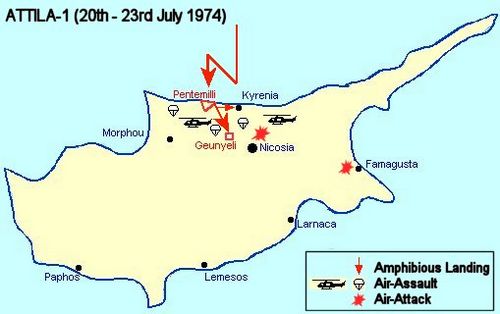
The Turkish codename for the invasion was "Operation Attila" with the map showing the main events including the unexpected change of direction of the invasion fleet (due to the poor initial choice of landing areas)
Opposing the invasion was a weakened National Guard. From the 18th July, approval for full mobilisation had been sought from Athens.
The response was...
"Do not proceed to mobilise, make no moves that could provide a pretext for Turkey to invade. Self-restraint".
Many units capable of opposing a Turkish landing were still in Nicosia or Paphos or had returned to base exhausted following their involvement in the coup. Their old British trucks and ageing Russian armoured vehicles were worn out and stocks of ammunition were greatly depleted. Almost without exception, the beginning of the invasion found National Guard units asleep in their camps.
The seaborne invasion began at 04:45hrs with a bombardment of coastal positions.
The Turkish invasion fleet leaving Mersin and heading for Cyprus
Just before 0600hrs, 27 transport planes dropped around 1000 paratroopers north of Nicosia with a further 7 dropping supplies and ammunition.
The British Defence Advisor's diary records one fleet of aircraft flying east to west and then, a few minutes later, a second fleet flying the same path but in the opposite direction. What he didn't know was that this second fleet were elements of the first that had overshot and turned 180º to return to the dropping zone.
The consternation this caused led to a widely spread drop of paratroops that was only later remedied by local Turkish Cypriots giving them guidance and support.
An hour later, further troops were brought in by helicopter until the enclave north of Nicosia held over 5000 Turkish troops.
The northern Greek Cypriot suburbs of Neapolis and Trakhones (south of the 1964 Green Line) were occupied by Turkish/Turkish Cypriot forces.
Turkish troops are dropped by parachute into the enclave north of Nicosia and are reinforced by helicopter sorties
The seaborne invasion also experienced some navigational difficulties and the first wave of assault troops numbering 1500 men with 15 tanks and 15 troop carriers did not begin to land until 0715hrs.
Two hours after the initial Turkish bombardment, orders were finally issued by National Guard HQ to repel the invasion. It was not until 0815hrs that these orders were confirmed by Athens.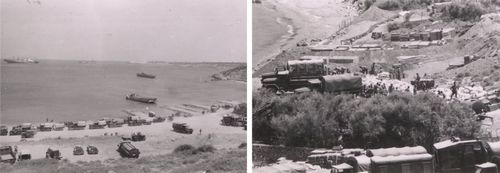
Pentemili (Five Mile) Beach known as Yavuz Beach by the Turkish army.......an open view and an image of supplies coming ashore
Click this link or the image for a larger view (opens in a new window)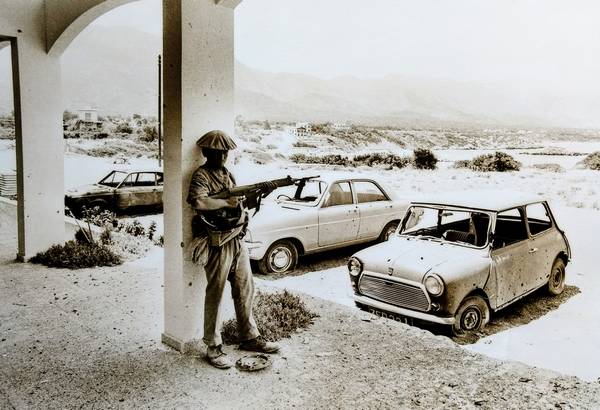
A rare image of a Turkish soldier from the first wave at Five Mile Beach..........image courtesy of Penny Douglas (whose reporter friend took the photograph)
Click this link for a larger version
The first movements of National Guard forces to the invasion area met with disaster; they were spotted and attacked by Turkish fighterbombers and suffered high casualties. Later units were ambushed by Turkish paratroopers and destroyed.
A convoy of National Guard vehicles (WW2 vintage Bedford QL trucks) was attacked by Turkish jets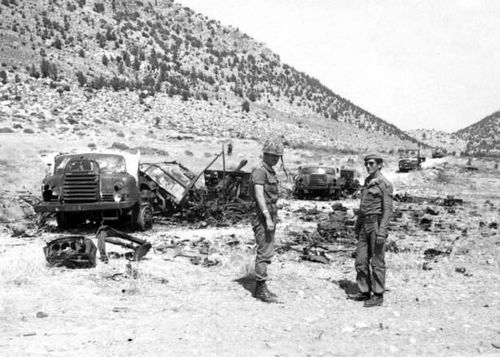
Another National Guard convoy ambushed by Turkish paratroops
The trucks appear to be Bedford RLs as used by the British Army in the 1950s
A mobilisation call for Cypriot Reservists and those able to bear arms was broadcast, but came too late and the volunteers were faced with confusion and a lack of resources. One Reservist Lieutenant (in discussion with the author) eventually managed to find a Martini rifle (Lee-Enfields which were leftovers from WW2) and twenty rounds of ammunition. Luckily he wasn't called upon to use the rifle as it didn’t work. In a final desperate measure to bolster the defences, thousands of Makarios loyalists (imprisoned by the coupists) were released from detention but this action had little effect.
An attack on the bridgehead was made at 10am by National Guard infantry together with the remnants of an artillery unit. The Turkish troops had been unopposed since landing and were grouped together without any cover. They were caught by surprise and suffered heavy losses.
A British airline pilot living in Cyprus records......."I have heard numerous first-hand reports from Cyprus Airways colleagues, who were mustered into the National Guard, of their disgust at having to mow down advancing hordes of ill-trained conscripts who just sauntered towards them across open fields. I have no doubt these accounts are accurate and knowing the people personally I empathise with their loathing of the unnecessary killing. One UN officer told me that they estimated the losses were in the region of seven Turks for each Greek (Cypriot). I don’t suppose we shall ever know the truth."
Turkish F100s return from Cyprus, National Guard T-34s destroyed from the air and a F-104 in the skies above Nicosia
Unease grew in Ankara as reports reached them of further effective attacks by the National Guard upon their vulnerable first wave.
The Turkish commanders prayed for daylight and their air power to save them and, as one Greek officer remarked, "the day is theirs, but the night is ours."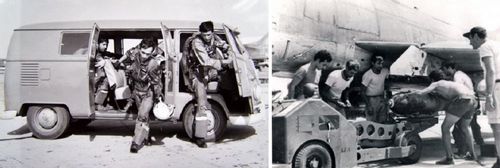
Turkish pilots are driven to their aircraft which are being made ready for fresh missions over Cyprus
Despite fierce and determined resistance by the National Guard, Turkish forces expanded their bridgehead and, by the time of the ceasefire (22nd July), had crossed the mountains and linked up with the Turkish Cypriot enclave north of Nicosia.
However, they failed in their objective to take control of the international airport.
For further information, see.........The History of Nicosia Airport.
Turkish forces cross the mountains and race towards the northern suburbs of Nicosia
After intense fighting by the invasion forces and equally stubborn resistance, the United Nations finally managed to negotiate a ceasefire on the 22nd July 1974.
This was to be followed by peace talks at an agreed venue.
The new Cyprus Government failed to gain international recognition and Nikos Sampson was forced to resign the day after the ceasefire was announced. Glafkos Clerides, the President of the House of Representatives, became the Acting President of Cyprus.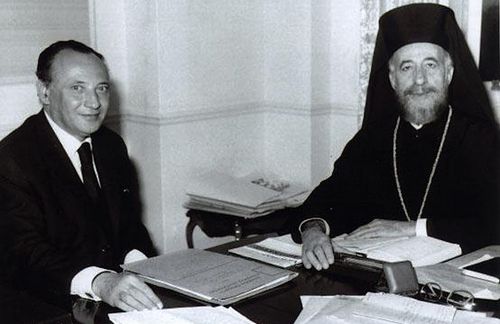
According to the Cyprus constitution, the President of the House of Representatives (Clerides LHS) would automatically take on the full powers of the President until his return
In Greece, fearing an all-out war with Turkey, the Junta was losing the support of senior military officers and their rule ended on July 24th 1974.
The first round of peace talks took place in Geneva between the 25th and 30th of July 1974 where, according to the BBC News, the participants, "signed a peace agreement to settle the Cyprus crisis."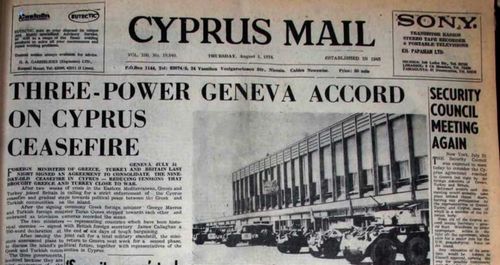
The first edition of the Cyprus Mail since the coup.....dated 1st August 1974
Significantly, the agreement prevented Turkish troops from making further advances and a UN-patrolled buffer zone (author....not a line) was to be established to keep warring Greek and Turkish factions apart.
Representatives from Greece, Turkey, the UK and the UN would determine the precise location and size of the buffer zone according to the positions of the opposing forces at 2000hrs GMT on the 30th July 1974.